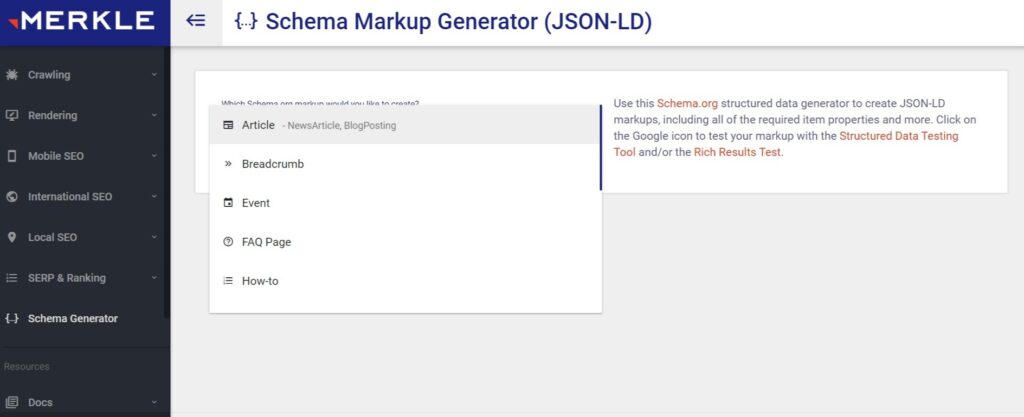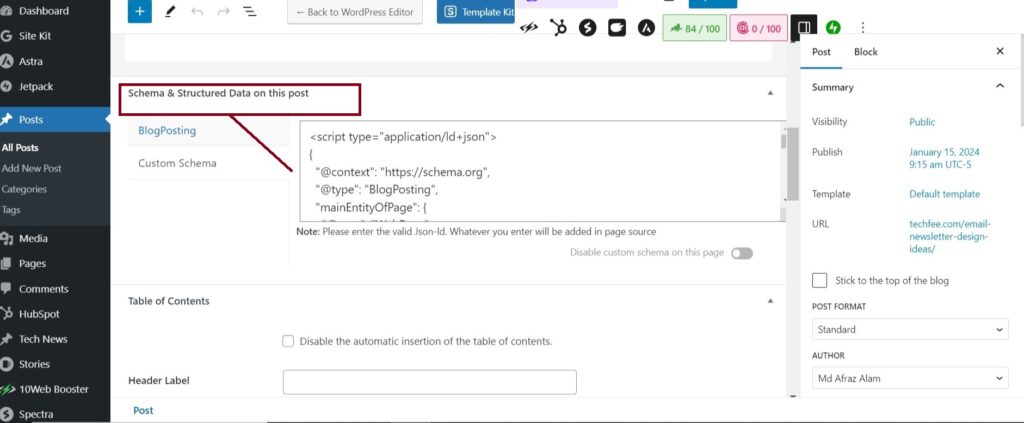Hey there, fellow digital enthusiasts! Ever wondered how the internet’s grand library gets organized? Remember the superhero music because the answer lies in structured data in SEO—a game-changer for your website.
Imagine your content not just being read by search engines but truly understood, making it stand out in the crowded online space. Fascinated? Let’s dig in!
So, what’s the deal with structured data? It’s like the decoder ring that helps search engines make sense of your content. Consider turning your website’s information into a language search engines speak fluently.
The result? Your content gets the VIP treatment in search results, with eye-catching snippets that grab attention.
Still with me? Good! Let’s continue!
Structured data isn’t just a buzzword; it’s the unsung hero that can take your website from zero to hero in the digital domain. Improved rankings and more clicks—this is what dreams are made of in the SEO world.
But hold onto your hats because there’s more to explore.
Ready for a deep dive into the structured data sea? This blog is your compass, guiding you through the what, why, and how of structured data in SEO.
We’ll break it down into bite-sized pieces, sharing tips, tricks, and real-deal strategies. And hey, we’ve got insights from the pros, those SEO wizards who’ve cracked the code.
Get set to boost your website’s mojo and ride the SEO wave like a pro. Please continue—it’s about to get exciting!
Understanding Structured Data

Structured data is like the secret sauce that makes your website more understandable for search engines. It’s all about organizing your information so that Google and friends can quickly get what your content is all about.
We should know about a few structured data types:-
1. Schema.org Markup
First, we’ve got Schema.org Markup, as the universal language search engines speak. It helps you label things on your page, like products or reviews, so that search engines can showcase them better.
Let’s consider an example of a Schema.org Markup for a product. Assume you have an online store selling smartphones and want to provide detailed information about a specific phone model, such as the iPhone 13.
Here’s how you can use Schema.org Markup:

2. JSON-LD
Then there’s JSON-LD, a technical term for embedding structured data in your website’s HTML. It’s like dropping a note to search engines, telling them exactly what’s what.
<script type=”application/ld+json”>
{
“@context”: “http://schema.org”,
“@type”: “Product”,
“brand”: “Apple”,
“name”: “iPhone 13”,
“image”: “iphone13.jpg”,
“description”: “The latest iPhone with advanced features.”,
“offers”: {
“@type”: “Offer”,
“priceCurrency”: “USD”,
“price”: “799.99”,
“availability”: “InStock”
}
}
</script>
In this example:
- @context: Specifies the context for interpreting the data, which is “http://schema.org” for Schema.org Markup.
- @type: Indicates the type of schema, in this case, it’s a “Product.”
- brand, name, image, and description: Provide information about the product.
- offers: Describes the pricing and availability details.
- @type: Specifies that this is an “Offer.”
- priceCurrency and price: Indicate the currency and price of the product.
- availability: States that the product is “InStock.”
You can place this JSON-LD code within the <head> section of your HTML document to convey structured data about the iPhone 13 to search engines.
- Microformats
Lastly, Microformats are a lightweight option for highlighting specific info like contact details. So, why bother with all this?
<div class=”vevent”>
<span class=”summary”>Tech Meetup</span>
<span class=”location”>123 Tech Street, Tech City</span>
<time class=”dtstart” datetime=”2024-02-01T18:00:00″>February 1, 2024, 6:00 PM</time>
<time class=”dtend” datetime=”2024-02-01T20:00:00″>February 1, 2024, 8:00 PM</time>
<span class= “description”>Join us for an evening of tech talks and networking!</span>
<a class=”url” href=”https://example.com/tech-meetup”>Event Details</a>
</div>
In this Microformats example:
- vevent: Indicates that this is an event.
- summary: Represents the name or title of the event (“Tech Meetup”).
- location: Specifies the address of the event (“123 Tech Street, Tech City”).
- dtstart and dtend: Provide the start and end times of the event, respectively.
- description: Offers a brief description of the event (“Join us for an evening of tech talks and networking!”).
- url: Includes a link to the event details.
This Microformats snippet provides a structured representation of the tech meetup event, making it easier for search engines and other tools to extract and understand key details.
Remember that Microformats are integrated directly into the HTML, offering a lightweight solution for marking up specific types of information.

Several tools are available to help you create Schema.org Markup for your website:-
These tools make the process more accessible, especially for those who may not be familiar with coding.
Here are a few popular ones:
Google’s Structured Data Markup Helper:
Link: Structured Data Markup Helper
Description: Google’s tool allows you to select the type of data you want to markup, paste in the HTML of your page, and then highlight and tag the relevant elements.
Schema Markup Generator:
Link: Schema Markup Generator
JSON-LD Schema Generator:
Link: JSON-LD Schema Generator
Understanding these structured data in SEO is your golden ticket to a better SEO game in 2024. It’s like telling search engines your website’s story in a language they can’t ignore, leading to higher rankings and happier users getting what they searched for.
Another tool that I mostly use to generate schema markup is technicalseotool. It is easy to use to generate schema markup for products, reviews, faqs, articles, web pages, etc.

Benefits of Structured Data in SEO
Imagine your site popping up in search results, not just as a link but with extra cool stuff like images, ratings, and more. That’s the magic of structured data, giving you those eye-catching rich snippets. It’s like dressing up your content and making it stand out.
Enhanced Search Results:
- Provides a clear understanding of webpage content to search engines.
- Results in more accurate and relevant search outcomes.
- Increases the visibility of the website in search results.
Rich Snippets:
- Adds extra information snippets alongside traditional search results.
- Includes elements like images, ratings, and other relevant details.
- Makes content visually appealing and informative to users.
Improved Click-Through Rates (CTR):
- Attracts more attention with visually appealing search results.
- Encourages users to click on the link due to enhanced presentation.
- It drives more organic traffic to the website.
In the ever-evolving realm of SEO, leveraging structured data brings these tangible benefits, boosting your website’s overall performance and rankings.
Structured Data Vs. Unstructured Data
The impact of structured data versus unstructured data on a website is profound and can significantly affect the website’s performance, user experience, and overall functionality.
Structured data refers to information organized and presented in a format easily understandable by both machines and humans. This data type is typically stored in databases and follows a predefined schema, allowing for efficient storage, retrieval, and analysis.
When implemented on a website, structured data can enhance search engine optimization (SEO), enabling search engines to understand better the content and context of the information presented.
This, in turn, can lead to improved search engine rankings, increased visibility, and a higher likelihood of attracting targeted organic traffic.
On the other hand, unstructured data needs a predefined format and is often more challenging for machines to interpret.
This can include textual content, multimedia files, and other types of information that do not conform to a rigid structure. While unstructured data allows for more creativity and flexibility in content creation, it can pose challenges regarding search engine visibility and user accessibility.
Search engines may need help to extract meaningful information from unstructured data, resulting in lower rankings and reduced discoverability.
In summary, the impact of structured data on a website is positive, leading to improved SEO, better user experience, and increased traffic.
On the contrary, unstructured data may hinder search engine visibility and make it more challenging for users and machines to interact with and extract valuable insights from the content.
Striking a balance between structured and unstructured data based on the website’s objectives and content strategy is crucial for optimizing overall performance and ensuring a positive user experience.
Table of Contents
ToggleImplementing Structured Data

Diving into the SEO game in 2024 means unlocking the power of structured data in SEO, and let’s start with the on-page stuff—it’s a big deal.
So, best practices first: sprinkle schema markup on your content to make it pop on search results. Whether it’s products, reviews, or events, this little extra info helps search engines understand your page better; voila, you get those fancy snippets.
But, watch out for the usual suspects – wrong schema types and outdated data. Keep it real, keep it accurate.
Now, you don’t have to be a coding wizard on the tech side. Use schema markup generator tools—they’re like your SEO sidekick, helping you avoid those embarrassing markup blunders.
And hey, remember compatibility. Your structured data must be the rockstar that plays well on any stage, whether WordPress, Shopify, or whatever platform you’re plugging into.
Make it easy for everyone, including search engines, and watch those rankings climb. SEO isn’t rocket science; it’s about making friends with structured data and getting the tech to dance to your digital marketing beat.
Structured Data and Content Types
So, structured data is like the superhero for SEO in 2024, giving search engines a clearer picture of your content. And guess what? It’s not playing favorites; it’s rocking the stage across different content types.
Take articles, for example. Structured data jazzes up your write-ups by adding cool stuff like author info and publication dates, making your content stand out and look more legit. Products get a boost, too – with nifty details like prices and availability, making online shopping a breeze for users.
Consider a blog article about “Top 10 Healthy Recipes for Busy Professionals.” In this example, I’ll demonstrate how you might implement structured data using Schema.org markup to enhance the article’s visibility in search results.
<!DOCTYPE html>
<html lang=”en”>
<head>
<meta charset=”UTF-8″>
<meta name=”viewport” content=”width=device-width, initial-scale=1.0″>
<title>Top 10 Healthy Recipes for Busy Professionals</title>
<!– Include the necessary structured data script –>
<script type=”application/ld+json”>
{
“@context”: “https://schema.org”,
“@type”: “Article”,
“headline”: “Top 10 Healthy Recipes for Busy Professionals”,
“datePublished”: “2024-01-18”,
“author”: {
“@type”: “Person”,
“name”: “Your Name”
},
“description”: “Discover quick and nutritious recipes to fuel your busy lifestyle.”,
“image”: “link-to-your-article-image.jpg”,
“publisher”: {
“@type”: “Organization”,
“name”: “Your Blog”,
“logo”: {
“@type”: “ImageObject”,
“url”: “link-to-your-logo.png”
}
}
}
</script>
</head>
<body>
<!– Your article content goes here –>
<h1>Top 10 Healthy Recipes for Busy Professionals</h1>
<p>Welcome to our collection of quick and delicious recipes perfect for busy individuals…</p>
<!– Rest of your article content –>
<!– Add more structured data for each recipe in the list –>
<script type=”application/ld+json”>
{
“@context”: “https://schema.org”,
“@type”: “Recipe”,
“name”: “Easy Avocado Salad”,
“image”: “link-to-recipe-image.jpg”,
“author”: {
“@type”: “Person”,
“name”: “Your Name”
},
“datePublished”: “2024-01-18”,
“description”: “A refreshing salad that’s ready in minutes, perfect for a quick lunch.”,
“recipeYield”: “2 servings”,
“recipeIngredient”: [
“2 ripe avocados”,
“1 cup cherry tomatoes, halved”,
“1/2 red onion, finely chopped”,
“2 tablespoons olive oil”,
“1 tablespoon balsamic vinegar”,
“Salt and pepper to taste”
],
“recipeInstructions”: “Step-by-step instructions for preparing the Easy Avocado Salad…”
}
</script>
<!– Repeat the structured data for each recipe in your article –>
</body>
</html>
This example uses JSON-LD (JavaScript Object Notation for Linked Data) to embed structured data in the HTML of the blog article. It provides information about the article and details for each recipe, such as name, image, author, publication date, description, ingredients, and instructions.
Search engines can use this structured data to understand better and present your content in search results. Remember to replace placeholder values like “Your Name,” “link-to-your-article-image.jpg,” and others with your actual information.
Now, let’s talk events. Structured data turns your event pages into stars, spilling the beans on dates, locations, and ticket info. That means more people discovering and showing up at your gathering. And local businesses?
Structured data gives them the spotlight by showcasing important deets like opening hours and reviews, making them more visible in local searches.
If you’re not riding the structured data wave in 2024, you’re missing out big time. It’s like giving your content a secret weapon for better rankings and making your online presence pop.
So, let’s get on board with the structured data vibe and watch those rankings soar!
Case Studies
Implementing structured data markup on e-commerce websites is a prime example of success.
By meticulously marking product pages with relevant schema, these sites have enhanced their visibility in search engine results pages (SERPs), providing users with more prosperous and informative snippets. This has increased click-through rates and led to a notable uptick in organic traffic.
Additionally, businesses that have implemented schema markup for their location information have experienced remarkable improvements in local SEO.
These structured data implementations ensure that search engines accurately understand and display business details in local search results, ultimately translating into higher rankings and increased visibility for potential customers.
In both cases, the strategic use of structured data has emerged as a critical driver for SEO success, showcasing its potential to unlock higher rankings and improve overall search performance in 2024 and beyond.
Structured Data and Mobile SEO
In the ever-evolving landscape of SEO, harnessing the potential of structured data has become critical, especially in mobile optimization.
A. Mobile-Friendly Structured Data: With the surge in mobile device usage, search engines have placed a premium on mobile-friendly content.
Structured data plays a pivotal role in ensuring that information is presented in a format easily digestible for mobile users.
Leveraging schema markup, a form of structured data, allows web admins to provide search engines with detailed context about the content on their pages, enhancing the overall mobile user experience.
By incorporating mobile-friendly structured data, websites can cater to the unique requirements of mobile devices, ensuring that search engines can efficiently interpret and present information to users on smaller screens.
B. Impact on Mobile Rankings: The integration of structured data has a tangible impact on mobile rankings. Search engines like Google increasingly rely on structured data to enhance their understanding of content and deliver more precise search results.
Mobile-friendly structured data improves content visibility and contributes to a more favorable user experience, a crucial factor in determining search rankings.
Prioritize the use of schema markup for essential details like product information, reviews, and FAQs to enhance the visibility of these elements in mobile search results.
Regularly test and validate the structured data using tools like Google’s Structured Data Testing Tool to ensure compliance with search engine guidelines.
Challenges in Implementing Structured Data
A. Common Hurdles:
Implementing structured data in SEO comes with challenges that businesses must navigate.
One common hurdle is the complexity associated with correctly marking up content. Ensuring that the structured data adheres to schema.org guidelines and is implemented accurately can be daunting, especially for websites with extensive and dynamic content.
Additionally, staying abreast of evolving search engine algorithms and their interpretation of structured data poses another challenge. The need for ongoing adjustments to meet the latest requirements can be time-consuming and resource-intensive, posing a significant barrier for some businesses.
B. Solutions and Workarounds:
Despite the challenges, there are practical solutions and workarounds to streamline the implementation of structured data. Leveraging specialized tools and plugins designed for schema markup can significantly simplify the process, reducing the risk of errors and ensuring compliance with schema.org standards.
Regular audits and updates to the structured data markup, aligned with algorithm changes, can help maintain its relevance.
Moreover, investing in employee training or seeking the expertise of professionals in the field can enhance the in-house capabilities for structured data implementation.
By addressing these common hurdles strategically, businesses can unlock the true potential of structured data in SEO and improve their online visibility.
Future of Structured Data in SEO

The future of structured data in SEO is poised for a transformative shift driven by emerging technologies and anticipated developments in the SEO landscape.
A. Emerging Technologies: As we move forward, artificial intelligence (AI) and machine learning (ML) are set to play pivotal roles in shaping the way search engines understand and rank content.
Advanced algorithms will utilize structured data to comprehend the context and relationships between different web page elements, enabling more accurate and contextually relevant search results.
Additionally, the rise of voice search and the increasing prevalence of rich media, such as videos and images, will necessitate more sophisticated structured data implementations to enhance content visibility in these diverse formats.
B. Anticipated Developments in SEO Landscape: Looking ahead, search engines are likely to prioritize user experience even more, and structured data will be a crucial factor in achieving this goal.
Schema markup will evolve to encompass a broader array of industries and content types, offering website owners more minute ways to describe their content.
Featured snippets and rich results, driven by structured data, will continue dominating search engine results pages (SERPs), influencing click-through rates and engagement.
The future of structured data in SEO is not just about meeting current standards but adapting to an evolving technological landscape, where its strategic implementation will be fundamental to improving rankings and ensuring optimal visibility in search engine results.
Measuring the Impact
Understanding and measuring the impact of structured data is paramount for achieving improved search engine rankings.
A. Key Metrics to Track: Implementing structured data offers a wealth of data-driven insights, and monitoring key metrics is essential to measure its effectiveness.
Keep a close eye on click-through rates (CTRs) for rich snippets, as they directly reflect the visibility of your content in search results.
Additionally, it tracks changes in organic traffic, user engagement, and conversion rates, focusing on how structured data positively influences these metrics.
Analyzing these key performance indicators will provide a comprehensive understanding of the impact and success of your structured data strategy.
B. Tools for Monitoring SEO Performance: Several tools can help monitor the performance of structured data. Google Search Console is indispensable for tracking rich results, error reports, and overall search performance.
Schema.org’s Structured Data Testing Tool helps ensure correct implementation.
SEO analytics tools like Moz, SEMrush, and Ahrefs provide in-depth insights into keyword rankings, backlink profiles, and overall website performance.
Leveraging these tools collectively empowers web admins to fine-tune their structured data strategies and stay ahead in the competitive SEO landscape.
As the digital realm evolves, harnessing the power of structured data and effectively measuring its impact will be pivotal for organizations aiming to boost their online visibility and rankings.
User Experience and Structured Data
The symbiotic relationship between UX and structured data lies in the ability of the latter to provide search engines with a clear and organized understanding of a webpage’s content.
By implementing structured data markup, websites can present information in a more digestible and meaningful format for users and search engines.
This structured approach enhances the overall UX by making it easier for visitors to find relevant information quickly, resulting in a smoother and more satisfying navigation experience.
Beyond its impact on search engines, structured data significantly enhances user engagement. Rich snippets, powered by structured data, enable search engines to display more informative and visually appealing results, increasing the likelihood of users clicking through to a website.
This not only boosts click-through rates but also ensures that users are more likely to engage with the content on the site, leading to prolonged stays and a deeper connection with the brand.
Leveraging Structured Data for Local SEO
A crucial aspect of this strategy is implementing Local Business Markup. This schema markup provides search engines with specific details about your business, such as its name, address, phone number, operating hours, and more.
This markup enhances the visibility of such information in search engine results, making it easier for local customers to find and engage with your business.
Additionally, Geo-Targeting Strategies are pivotal in local SEO by tailoring content and promotions based on the user’s location.
Leveraging structured data to incorporate geo-targeted keywords and location-specific landing pages and ensuring consistency in NAP (Name, Address, Phone number) data across online platforms reinforces local relevance and strengthens your business’s chances of appearing in local search results.
Businesses can amplify their online presence, improve rankings, and connect with the right audience by seamlessly integrating Local Business Markup and Geo-Targeting Strategies.
<script type=”application/ld+json”>
{
“@context”: “http://schema.org”,
“@type”: “LocalBusiness”,
“name”: “Your Business Name”,
“address”: {
“@type”: “PostalAddress”,
“streetAddress”: “123 Main Street”,
“addressLocality”: “Cityville”,
“addressRegion”: “State”,
“postalCode”: “12345”,
“addressCountry”: “USA”
},
“telephone”: “+1-555-555-5555”,
“openingHours”: “Mo,Tu,We,Th,Fr 09:00-17:00”,
“geo”: {
“@type”: “GeoCoordinates”,
“latitude”: 37.7749,
“longitude”: -122.4194
},
“url”: “http://www.example.com”,
“sameAs”: [
“https://www.facebook.com/YourBusiness”,
“https://twitter.com/YourBusiness”,
“https://www.linkedin.com/company/your-business”
]
}
</script>
Let’s break down the key elements:
@type: “LocalBusiness”: Indicates that the markup is for a local business.
“name”: Your business name.
“address”: Includes details about your business location, such as street address, locality, region, postal code, and country.
“telephone”: Your business phone number.
“openingHours”: Specifies the business hours.
“geo”: Provides the geographic coordinates (latitude and longitude) of your business location.
“url”: Your business website URL.
“sameAs”: Links to your business profiles on social media platforms, helping search engines associate your website with your social media presence.
By implementing structured data like this, search engines can better understand the context of your business information. This can lead to improved visibility in local search results, especially in features like the Google Knowledge Graph, local pack, and other rich snippets that enhance the user experience.
International SEO and Structured Data
Using structured data is super important in SEO, especially for International SEO.
A. Multilingual Markup is a big deal here. It means adding unique tags to your website to tell search engines about the languages you use and the regions you’re targeting.
This helps search engines guide users to the correct version of your page based on their language and location. It’s like a personalized welcome for your visitors!
B. Global SEO Strategies are also crucial. This involves planning out how to reach people all around the world. It includes finding the right keywords for different languages, creating content that respects different cultures, and building links that connect you internationally.
By combining structured data and global SEO strategies, you make your website more search engine-friendly and create a welcoming online space for people from different parts of the world.
If you prefer to watch a video tutorial, go through this video below; Jaume Ros has explained very well how to implement structured data.
How to Add Structured Data to a Website
Adding structured data to a website involves incorporating metadata in a specific format to provide search engines with more information about the content on your pages.
This helps search engines understand the context and purpose of the content, leading to better search results and enhanced rich snippets.
Here are the steps to add structured data to a website:
Understand Structured Data:
Familiarize yourself with structured data formats such as JSON-LD (JavaScript Object Notation for Linked Data), Microdata, and RDFa.
JSON-LD is the recommended format by significant search engines.
Identify Content for Structured Data:
Determine the content on your website that could benefit from structured data. This could include articles, events, products, reviews, recipes, and more.
Choose the Appropriate Schema Markup:
Visit the Schema Markup Generator (JSON-LD) to find the appropriate schema markup for your content and generate it carefully. This tool provides a standardized option to choose that search engines understand. Choose the most relevant schema type for your content.
Example of JSON-LD for an article:
{
“@context”: “https://schema.org”,
“@type”: “Article”,
“headline”: “How to Add Structured Data to a Website”,
“datePublished”: “2024-01-18”,
“author”: {
“@type”: “Person”,
“name”: “Your Name”
},
“image”: “URL_TO_FEATURED_IMAGE”,
“publisher”: {
“@type”: “Organization”,
“name”: “Your Organization”,
“logo”: {
“@type”: “ImageObject”,
“url”: “URL_TO_LOGO_IMAGE”
}
},
“description”: “A guide on adding structured data to a website.”
}

Insert Markup into HTML:
Paste the generated JSON-LD markup into the HTML of your webpage. Insert it within the <script> tag in the <head> section or just before the closing </body> tag.
Or, in WordPress, there comes an option to insert the code with the help of the RANKMATH SEO plugin; you can directly paste the code into the WordPress editor.
Validate Structured Data:
Use Google’s Structured Data Testing Tool or similar tools to validate your structured data. This ensures no errors in your markup and that search engines can correctly interpret the information.
Submit Sitemap to Search Engines:
Update your website’s sitemap to include the URLs of pages with structured data. Submit the updated sitemap to search engines like Google using their webmaster tools.
Monitor Performance:
Keep an eye on search engine analytics to monitor the performance of your structured data. Check for changes in search visibility, click-through rates, and rich snippet displays.
By following these steps, you can enhance the visibility of your website in search engine results and provide users with more informative snippets.
Supercharge Your SEO in 2024: Unleash the Power of Structured Data with Our Expert Implementation Services!
Elevate Your Rankings, Boost User Experience, and Dominate Local & International SEO effortlessly. Let's Transform Your Website Together – Connect with Us Now for Seamless Structured Data Integration and Skyrocket Your Online Presence!
Connect Me Directly HereConnect Me On Upwork!Conclusion
In conclusion, delving into structured data in SEO has revealed a transformative landscape for SEO strategies in 2024.
By comprehending the nuances of structured data and embracing its implementation, businesses can unlock many benefits, ranging from enhanced search engine rankings to improved user experiences across various platforms.
Despite the challenges associated with its integration, the future of structured data in SEO appears promising, with innovations and advancements continually shaping the digital landscape.
As we navigate the dynamic intersection of structured data and SEO, the key lies in adaptability, creativity, and a keen understanding of user behavior.
Businesses can harness their power to stay ahead in the ever-evolving digital ecosystem by measuring the impact and leveraging structured data for local and international SEO endeavors.
As we move forward, structured data stands as a fundamental tool, empowering websites to not only meet the demands of search engines but to deliver a seamless, enriched experience for users in the dynamic years ahead.
So, take advantage of this element. Go ahead and start implementing structured data today on your website and see your site performing better than before.
I hope you have found this information helpful; if yes, please comment below with your valuable feedback and share it with others.
Also, please subscribe to the email newsletter to get these kinds of informative content directly in your inbox.
Frequently Asked Questions
What is structured data, and how does it impact SEO?
Structured data is a standardized format for organizing and presenting information on the web. It uses schema markup to provide context to search engines about the content on a webpage. This helps search engines better understand and index the content, improving visibility and relevancy in search results. Structured data positively impacts SEO by enhancing the presentation of search snippets, enabling rich results, and increasing the likelihood of featured snippets for relevant queries.
Can you provide examples of successful SEO improvements through structured data?
Examples of successful SEO improvements through structured data include higher click-through rates due to enhanced search snippets, increased visibility in search results through rich snippets (such as star ratings and product information), and improved chances of attaining featured snippets for relevant queries.
What are the common challenges businesses face when implementing structured data for SEO?
Common challenges businesses face when implementing structured data for SEO include the complexity of schema markup, technical implementation issues, maintaining consistency across the website, staying updated with evolving schema standards, and ensuring that the structured data accurately represents the content.
How does structured data contribute to mobile SEO, and why is it essential for mobile-friendly websites?
Structured data contributes to mobile SEO by providing search engines with clear and organized information about a webpage's content. It enhances the mobile user experience by enabling rich results and featured snippets, improving visibility in mobile search results. For mobile-friendly websites, structured data is essential as it helps search engines better understand and present content, leading to enhanced mobile search rankings and a more user-friendly mobile browsing experience.
What are the best practices for on-page implementation of structured data?
Best practices for on-page implementation of structured data include:
- Use Relevant Schema Markup: Choose appropriate schema types that accurately describe the content on your page.
- Follow Guidelines: Adhere to search engine guidelines, such as those provided by Google's Structured Data Markup Helper.
- Integrate Markup in HTML: Implement structured data directly in the HTML code of your page.
- Ensure Accuracy: Provide accurate and up-to-date information in your structured data to avoid misleading search engines and users.
- Maintain Consistency: Keep the structured data consistent with the content on the page to avoid confusion.
- Test with Structured Data Testing Tools: Use tools like Google's Structured Data Testing Tool to ensure proper implementation and identify any issues.
- Prioritize Key Content: Focus on marking up key content, such as product details, reviews, or events, to maximize the impact of structured data.
- Optimize for Mobile: Ensure that structured data is implemented to enhance the mobile user experience, considering the increasing importance of mobile SEO.
What role does structured data play in local SEO, and how can businesses leverage it for local rankings?
Structured data plays a crucial role in local SEO by providing search engines with specific information about a business's location, services, and reviews. Businesses can leverage structured data for local rankings by implementing LocalBusiness or LocalBusinessSchema markup on their websites. This helps search engines understand the local context, enhances the appearance of the business in local search results, and increases the chances of being featured in local packs and map listings. This improved visibility and context contribute to higher local rankings and increased relevance for users searching in specific geographic areas.
Is there a connection between structured data and e-commerce SEO, particularly for product markup?
Yes, there is a significant connection between structured data and e-commerce SEO, particularly for product markup. Implementing product schema markup provides search engines with detailed product information, including prices, availability, and reviews. This enhances the visibility of product listings in search results, increases the likelihood of rich snippets, and improves the overall performance of e-commerce websites in search rankings.
How does structured data impact video content and SEO on platforms like YouTube?
Structured data impacts video content and SEO on platforms like YouTube by providing additional context to search engines. Video schema markup, such as VideoObject, helps search engines understand details about the video, such as its title, description, duration, and thumbnail. This information enhances the visibility of videos in search results, increases the likelihood of appearing as rich snippets, and improves the overall SEO performance of video content on platforms like YouTube.
What is the relationship between voice search and structured data, and how should websites prepare for voice-activated SEO?
The relationship between voice search and structured data lies in the latter's ability to provide context and clarity to search engines. Structured data helps search engines understand and organize content, making it more accessible for voice search queries. To prepare for voice-activated SEO, websites should prioritize implementing structured data, particularly schema markup that aligns with conversational queries. This includes marking up key information and ensuring content is concise and well-structured to improve chances of being featured in voice search results.
How does structured data impact the overall ranking of a website in search engine results?
Structured data positively impacts the overall ranking of a website in search engine results by providing clear context about the content. Search engines use structured data to understand better and categorize information, leading to improved relevance. Rich snippets and enhanced search results generated from structured data can enhance click-through rates and user engagement and ultimately contribute to higher rankings in search engine results pages.







